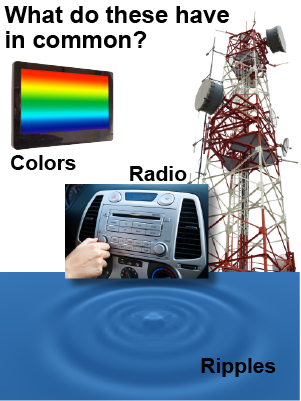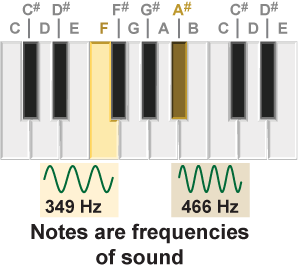|
We observe things move in two fundamentally different ways. A car moving from one place to the next is well described by concepts of speed and position. The vibration of a guitar string, however, has additional complexity that needs additional physical concepts to describe. In the physics of waves, sound, and light, we will often use the term frequency to describe how quickly the vibration repeats. 
| 
|
A guitar playing the note “A” oscillates back and forth at a frequency of 440 vibrations per second. In an acoustic guitar, the string vibrates the guitar top, which sets off a traveling oscillation in air, called a sound wave. Colors, cellphones, radio, and the ripples on a pond are other examples of waves and their applications. 
|
 Sound waves carry both energy and information. Music is a form of information. When pressed, the keys of a piano create different frequencies of sound waves. A song is physically a complex “sonic image” created by your brain from patterns of frequency and loudness received by your ear. Guitars and pianos use vibrating strings of different length and tension to make different frequencies. Trumpets and pipe organs use vibrating columns of air.
Sound waves carry both energy and information. Music is a form of information. When pressed, the keys of a piano create different frequencies of sound waves. A song is physically a complex “sonic image” created by your brain from patterns of frequency and loudness received by your ear. Guitars and pianos use vibrating strings of different length and tension to make different frequencies. Trumpets and pipe organs use vibrating columns of air. 
|
You see everything around you because it either emits or reflects light that then travels to your eyes. This is the physics of light and the technology of optics. Light travels through air, water, glass, or even empty space. Fundamentally, light is a wave in the electromagnetic field everywhere around us. Light ordinarily travels in straight lines, but it can be deflected by mirrors or lenses (such as in a telescope) to form images.
 |
In 1920 a telephone conversation required a direct wire connection between both callers. Today, more than 30,000 two-way calls can be carried over a single strand of an optical fiber using different frequencies (colors) of light waves. Vast networks of optical fiber cables form the neural pathways of the global Internet and many everyday applications such as the ability to receive streaming movies are totally dependent on this technology. Optical fibers can carry information thousands of miles clearly, without being scrambled into meaningless static. 
|

 |
Many people envision the computers of tomorrow running on circuits of light instead of circuits of electricity. Light travels at 186,000 miles per second. If such photonic computers become a reality, you could one day have a device the size of a loaf of bread that could match the world's fastest supercomputer that today fills a room. 
|
A wave is a traveling oscillation that carries information. What information does each of the following type of wave convey? - water waves
- sound waves
- light waves
- a vibrating guitar string
 |
- Water waves are the most easily observed waves, and the information they carry is no more complex than the movement of the water. This information is still very important as water waves can have huge effects on ocean life, boats, and coastlines.
- Sound waves are oscillations of pressure that can travel through air, water, or any material. The ears and brain interpret sound waves. They can carry information such as music, speech, or weather. Anything you hear is information from sound waves.
- Light is an electromagnetic wave that is visible to the human eye. Your eyes interpret light to see objects and colors. Anything you see is information from light waves.
- Physically vibrating objects are the basis of music. A vibrating string on a guitar will transfer energy and information to the air around it to produce sound. This sound conveys the musical notes that the ear interprets as music.

|
Light is an electromagnetic wave. Which of the following are also types of electromagnetic waves? - tidal waves
- gamma rays
- radio waves
- sound waves
- I and II only
- II and III only
- II, III, and IV only
- I, II, III, and IV
 |
The correct answer is b. Electromagnetic waves are waves with electric and magnetic components that travel through empty space and materials. These waves include gamma rays, x-rays, ultraviolet light, visible light, infrared light, microwaves, and radio waves. 
|
| |
|

